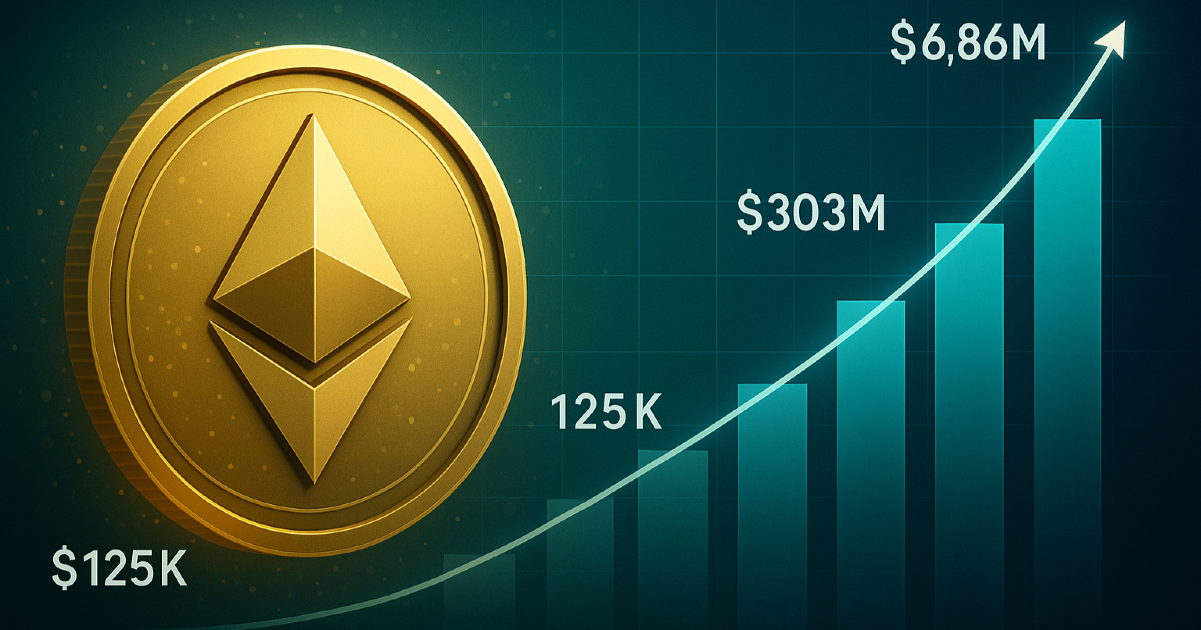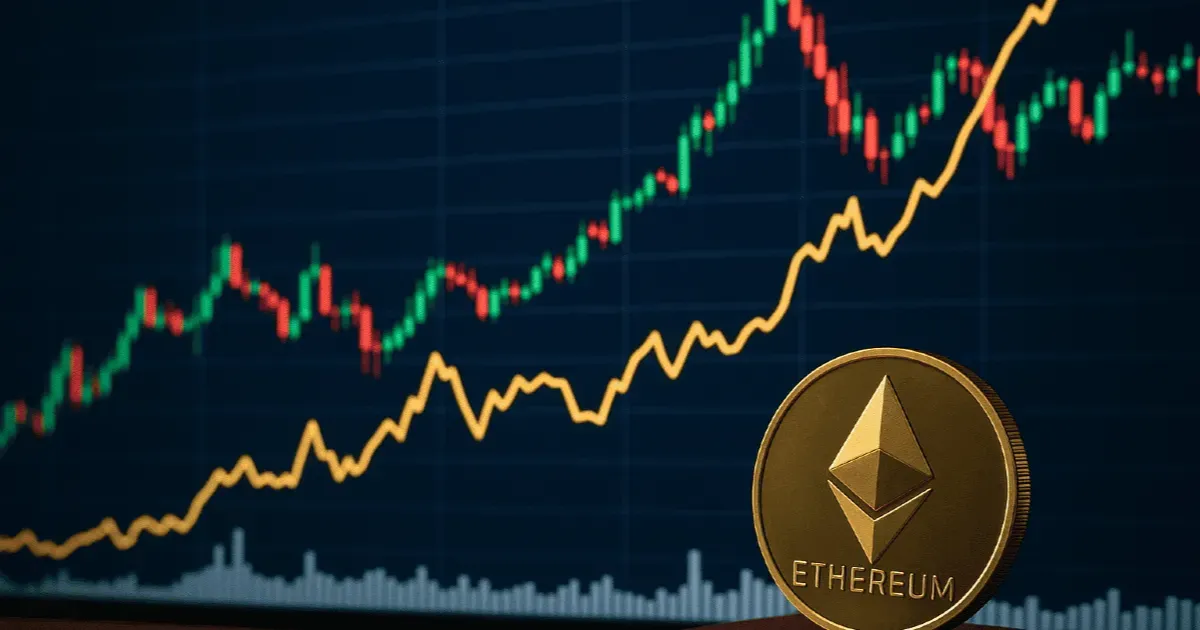ETH surges as BitMine plans $20B purchase, boosting market optimism
Ethereum Pushes Toward Record Levels
Ethereum has entered a powerful rally, breaking into its highest price range since late 2021. The digital asset surged over 6% in a single day, reaching within striking distance of its all-time high. Fueling the momentum is a blockbuster announcement from BitMine: the company plans to raise $20 billion to purchase Ethereum, a move that would significantly increase its share of the asset’s total supply.
For investors, this signals not just short-term excitement but a potentially long-lasting shift in market structure. With BitMine’s aggressive acquisition plan, Ethereum is solidifying its position as more than just a utility blockchain; it’s emerging as a core institutional holding.
BitMine’s Big Bet on Ethereum
BitMine’s strategy has shades of MicroStrategy’s historic Bitcoin accumulation, but with a focus on ETH. Tom Lee, well-known for his time at Fundstrat and a longtime advocate of Ethereum’s potential, now leads the company as chairman. His vision is clear: secure a substantial stake in Ethereum’s circulating supply and position BitMine as a market-shaping treasury holder.
If the raise succeeds, BitMine’s holdings could approach $24.5 billion in ETH. That’s not just a strong bet; it’s a statement. In a market where institutional adoption often centers on Bitcoin, such a significant Ethereum-focused play carries strategic weight.
Institutional Momentum Is Building
The timing couldn’t be better for a move like this. Across the financial sector, institutions are starting to treat Ethereum as a dual-purpose asset: one that functions both as a store of value and a critical layer for decentralized applications.
Other companies have been quietly increasing their ETH reserves. SharpLink Gaming, for instance, has recently expanded its treasury allocation, reflecting a growing acceptance of Ethereum as a reliable long-term asset. The narrative is shifting. Ethereum isn’t just riding on the coattails of Bitcoin’s adoption curve; it’s carving out its own role as a treasury reserve.
The Peter Thiel Connection
Institutional confidence in BitMine’s plan has been further strengthened by the disclosure that Peter Thiel’s Founders Fund now holds a 9.1% stake in the company. This high-profile endorsement immediately boosted BitMine’s stock price and underlined the credibility of its $20 billion fundraising target.
Thiel’s involvement suggests that BitMine’s approach is not just opportunistic but part of a broader thesis about Ethereum’s role in the future of finance. With his history of backing transformative technologies, Thiel’s backing may help attract other major investors to the raise.
Why Ethereum, Not Bitcoin?
For years, Bitcoin has been the default choice for corporate treasuries seeking crypto exposure. It’s liquid, widely understood, and its narrative as “digital gold” resonates with traditional finance. But Ethereum offers something different: its role as the settlement layer for decentralized finance, NFTs, tokenized assets, and blockchain-based applications adds a dimension of utility that Bitcoin lacks.
For institutional investors, this utility can translate into resilience. While Bitcoin’s demand is often tied to macroeconomic factors, Ethereum’s demand is reinforced by on-chain activity: decentralized exchanges, staking, and an expanding layer-2 ecosystem.
ETH Price Action and Market Sentiment
The market’s reaction to BitMine’s announcement was immediate. Ethereum’s price jumped, and derivatives markets saw a sharp increase in open interest, particularly on the long side. Trading volume on major exchanges spiked, reflecting renewed retail and institutional participation.
Technically, Ethereum is now trading just under a key resistance level near its all-time high. Breaking that level could open the door to a new price discovery phase, especially if BitMine’s fundraising campaign gains momentum in the coming weeks.
The Strategic Implications of a $20B ETH Raise
If successful, BitMine’s purchase could have ripple effects across the market:
- Supply Shock Potential – Large-scale acquisitions can remove significant liquidity from the market, potentially creating upward price pressure.
- Institutional Signaling—A purchase of this magnitude validates Ethereum as a strategic corporate asset.
- Treasury Model Expansion—Other companies may follow suit, diversifying beyond Bitcoin into Ethereum.
- Ecosystem Confidence—Strong treasury backing can boost confidence in Ethereum-based projects, attracting further development and investment.
Comparisons to MicroStrategy and Michael Saylor
Michael Saylor’s Bitcoin acquisition strategy transformed MicroStrategy from a mid-tier tech firm into a Bitcoin proxy stock. A similar dynamic could emerge with BitMine. If Ethereum prices rise significantly, BitMine’s treasury holdings could become a primary driver of its market value.
However, Ethereum differs from Bitcoin in important ways. Its proof-of-stake consensus mechanism generates staking yields, creating potential passive income streams for treasury holders. This adds a financial incentive that Bitcoin cannot match.
The Role of Ethereum ETFs and Regulation
Part of Ethereum’s bullish momentum also comes from the broader market structure. The introduction of Ethereum exchange-traded funds (ETFs) has lowered the barrier for institutional participation. Funds can now gain ETH exposure without directly handling the asset, while still benefiting from its price performance.
On the regulatory front, new stablecoin legislation and clearer guidance around staking are contributing to institutional comfort with Ethereum. While regulatory risks remain, the trend toward greater clarity is seen as a long-term positive for adoption.
Risks and Considerations
While BitMine’s plan is ambitious, it is not without risks:
- Execution Risk – Raising $20 billion is a massive undertaking, and market conditions can change rapidly.
- Price Volatility—Ethereum’s price can swing dramatically, even in bullish cycles.
- Regulatory Uncertainty—Shifts in securities or commodities classifications could impact Ethereum’s appeal to large investors.
- Market Reaction—A perceived over-concentration of ETH holdings in one entity could raise decentralization concerns within the community.
Despite these risks, the potential upside appears to outweigh the downside in the eyes of BitMine and its backers.
The Bigger Picture: Ethereum’s Institutional Era
BitMine’s announcement marks another milestone in Ethereum’s journey from a developer-centric network to a globally recognized financial asset. Just as Bitcoin had its institutional moment in the early 2020s, Ethereum now seems to be stepping into that role.
The key difference? Ethereum’s value proposition is not only scarcity-driven but also usage-driven. As the base layer for decentralized finance, NFTs, gaming, and tokenized assets, Ethereum captures economic activity in ways that extend beyond speculative holding.
Conclusion: A Defining Moment for ETH
Ethereum’s surge to multiyear highs is about more than just price action; it’s about validation. BitMine’s $20 billion plan, coupled with growing institutional interest, signals that ETH is ready to stand alongside Bitcoin as a primary corporate treasury asset.
If the raise succeeds, it could catalyze a new wave of Ethereum adoption, reshape treasury management strategies, and set the stage for ETH to reach and potentially surpass its previous all-time highs.
As Tom Lee and BitMine move forward, the crypto world will be watching closely. Whether you’re an institutional investor, a retail trader, or simply an observer of financial innovation, one thing is clear: Ethereum’s story is far from over, and the next chapter could be its most exciting yet.






